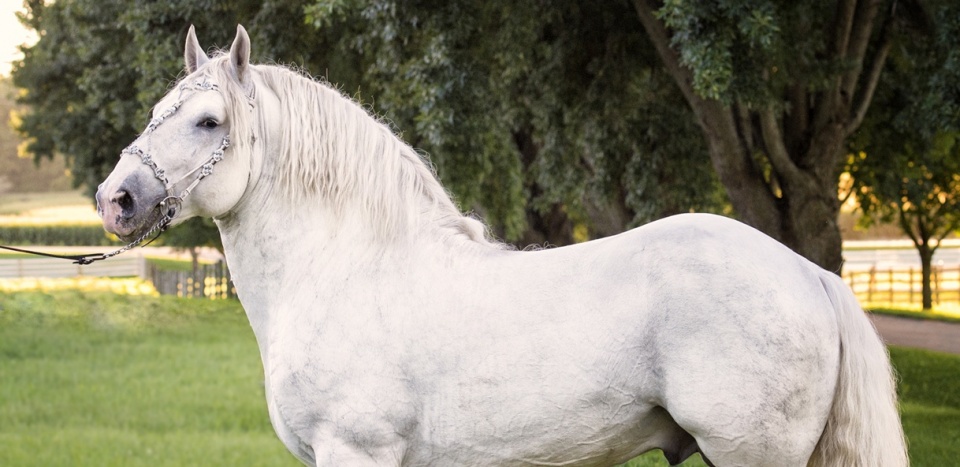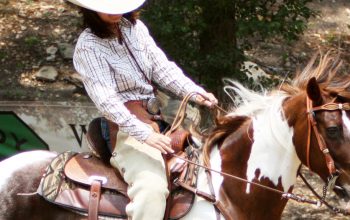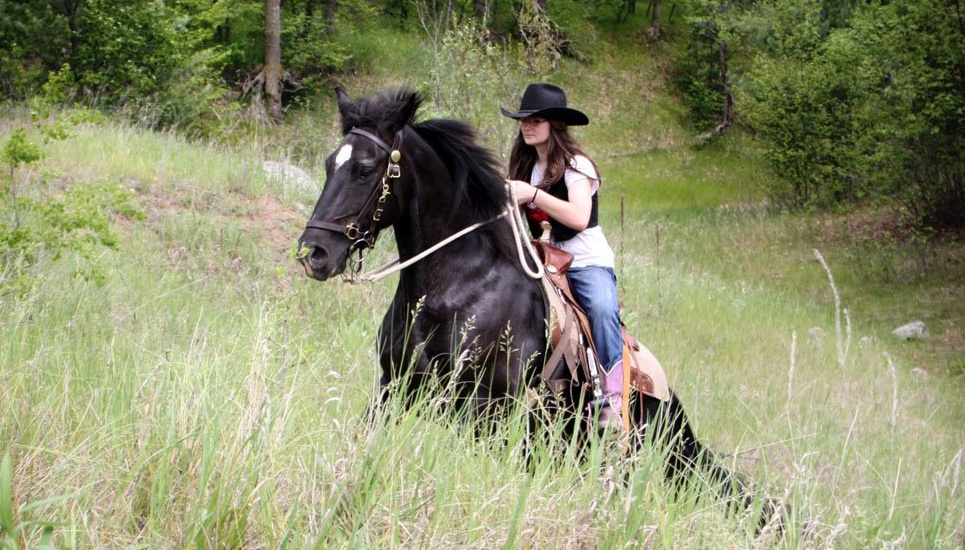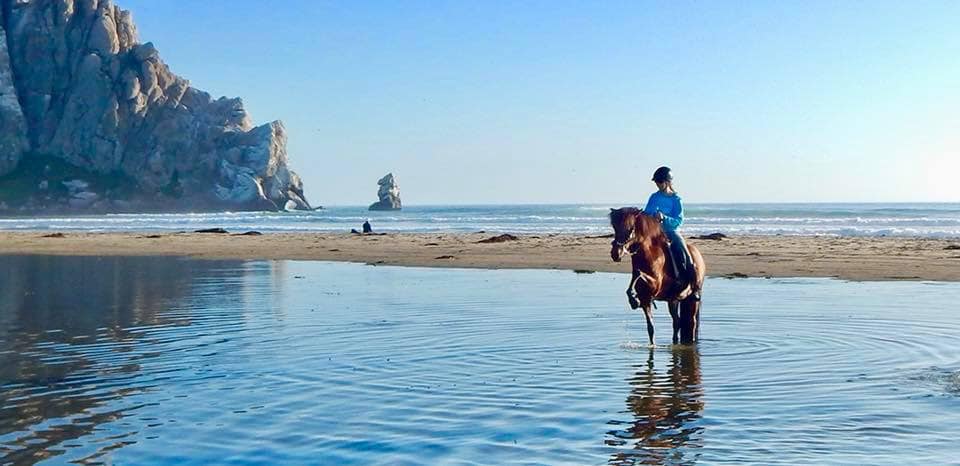
The White Marble Horse of France
Story by Lynn Gennrich with photography by Phyllis Burchett
“If your dreams are of a fairy tale horse, this is him. He steps out of the distant past shrouded by mists of time. He cocks his head as if he is listening to the sound of long lost wars. He stands looking all the noble steed that he is.” ~ Lynn Gennrich
If there ever was a breed of horse that stepped out of the midst of time, it would be the Boulonnais. Listening, as if you can hear the hooves from battle cries of wars long ago, forgotten by man, this is the horse the fairy tale princess bride would ride. The horse that God surely rides, for if he created a finer breed he kept it to himself. This horse, the Boulonnais, appears as an elegant and noble beast, standing atop a hill, as though carved in marble.
Despite their size, the Boulonnais continue to be extremely agile with the ability to achieve suspension in air
Though there are several theories as to the true origin of this breed it is thought to be traced back as far as the Crusades, in an effort to create a fast, strong and agile warhorse for knights to ride in battle. The breed has many characteristics that are different from other drafts and were used to upgrade many of the northern European drafts. While draft in size, they are not in temperament. Their coats are soft and silky to the touch with a double mane, a long luxurious tail and lack the typical heavy feathering on their legs. The Boulonnais of today range in height between 14.3 to 16.3 hands or more with substantial but not coarse bone. Other characteristics of the breed include a short elegant head, flat and broad between the eyes with a short muscular neck. With their large kind eyes the Boulonnais exhibits a full chest, rounded rib cage, a sloping shoulder and a nicely rounded croup. Despite their powerful muscular build the Boulonnais is an intelligent breed with an elegant appearance not often seen in heavy draft breeds. They exhibit a quick and lively step with the endurance to travel long distances. While the French breed registry only allows chestnut, gray and black colors the clear majority of horses are gray. Because of the fineness of the skin and delicate appearance of the veins the horse has been described as looking like “polished marble”, leading to its “White Marble Horse” nickname.

In the 1600’s the Boulonnais were bred as the first true heavy mounted war and work horse. While there is some speculation that during this time, Arabian and Andalusion horses were introduced into the breed to create more fire, that is no longer the case. DNA testing done by a French stud farm, as well as at Texas A&M by Dr. Gus Cohran has determined that the Boulonnais of today exhibit no other DNA markers of outside breeds. Despite their size, they continue to be extremely agile with the ability to achieve suspension in air. Thus, not only is the Boulonnais a true work horse but also a good riding horse.
The breed has lingered on the edge of extinction since the World Wars and is considered a heritage breed that should be classified endangered
Pre-1900’s the Boulonnais was imported to the U.S., but their majority and popularity remained in France with their numbers estimated to be close to 660,000. Despite this high number, World War I and World War II brought these numbers crashing to their knees, decimating the breed, leaving less than one thousand of these mighty horses to date. The breed has lingered on the edge of extinction ever since and is considered a heritage breed that should be classified endangered. As of 2010 falling demand for this breed means that 60% of the Boulonnais bred in France are destined for meat. Today they are bred for pleasure but if the colts are not sold before weaning and gelding, they will be sold to the butchers. 95% of the colts born in 2016 are no longer with us.

For me, this was the breed of my dreams. Twenty-six years ago, I bought a breed book and fell in love with the Boulonnais, the amazing white horse. I had never heard of them before. For years, I looked to see if there were any in the U.S. I dreamt a wealthy person would come along, buy a Boulonnais and bring them to our horse fairs, so for just one day I could see, touch, love one. Until late in January of 2015 their whereabouts stayed hidden from me. I was thrilled when I finally found them in France. Little did I know, at that point how much they would change my life and how much passion they would instill in me. I never thought I would get a chance to meet these wonderful animals or go to France, but that is exactly what I did.
In 2015 I flew to France. Tears of joy swept down my face seeing my first Boulonnais, the stallion Timide de L’ecurie. I never thought I would see one, let alone own one. I eventually bought two yearlings from this gentleman, one being a colt of Timide’s, a very special horse. In five days, we went to as many Boulonnais breeders as we could, thanks to the introductions from the first breeder. They were only too happy to accommodate us with the realization that their breed was not forgotten and at least one American cared and carried an extraordinary amount of passion for this breed.

Ben Hur De Bernaville and Caline de la Course were imported in the summer of 2015, with Caline having been bred to Oslo 85 prior to being shipped. The foal, a filly, was born on April 1, 2016. Both Caline and the filly are owned by Laura Sallis of Wisconsin. In February of 2016 another colt, Fier De L’ecurie and two fillies, Facile De L’ecurie and Firfole Du Buck joined us. Now America has six Boulonnais in the country and we have started to bring the breed back to the U.S.
For the first time, in 115 years, the first two Boulonnais’s, a majestic 4yr old Stallion “Ben Hur De Bernaville” and a 3yr old bred mare”Caline de la Course” touched American soil in Chicago, on July 9th, 2015.
 I have now been to France three times, but never for sightseeing, only to visit Boulonnais breeders and places where the horses are. In Calais, there is a mounted police unit composed of six Boulonnais geldings, a stunning sight. However, my heart belongs Boulonnais breeder, Emile Degardin, who celebrated his 96th birthday on May 5, 2020. This delightful, charming and funny young man who rides one mare side saddle and ties three other mares to her tail as they proceed down the lane to their turnout paddock, credits his horses for giving him a long life. Emile’s love for the Boulonnais goes back decades, as he risked his life to save his precious horses.
I have now been to France three times, but never for sightseeing, only to visit Boulonnais breeders and places where the horses are. In Calais, there is a mounted police unit composed of six Boulonnais geldings, a stunning sight. However, my heart belongs Boulonnais breeder, Emile Degardin, who celebrated his 96th birthday on May 5, 2020. This delightful, charming and funny young man who rides one mare side saddle and ties three other mares to her tail as they proceed down the lane to their turnout paddock, credits his horses for giving him a long life. Emile’s love for the Boulonnais goes back decades, as he risked his life to save his precious horses.
During World War II Emile protected his horses from the Germans by hiding them in the forest and keeping them on the move. No easy task, as many of the battles were fought over their breeding grounds. I am so thankful for brave men like Emile, as we all should be. I tell people in France that Emile is famous here, as I share his videos of his beloved Boulonnais. It doesn’t matter that we don’t know what he is saying.
My dream has sent me on my own personal mission to do what I can to save this breed and bring attention to them here in the U.S. One of our long-term goals is to establish a viable breeding program. Another one of my goals is to have a six-horse hitch of Boulonnais mares to drive in the Rose Bowl Parade. In the meantime, we will continue to educate the public on the Boulonnais, ride in parades, attend draft shows, maybe a horse pull or two, and ride. We have great hope for this breed, the sky is the limit and their future remains ahead of them.
For more information on the Boulonnais you can visit the North American Boulonnais Association at www.naboulonnaisassociation.com or find them on their Facebook group page.





